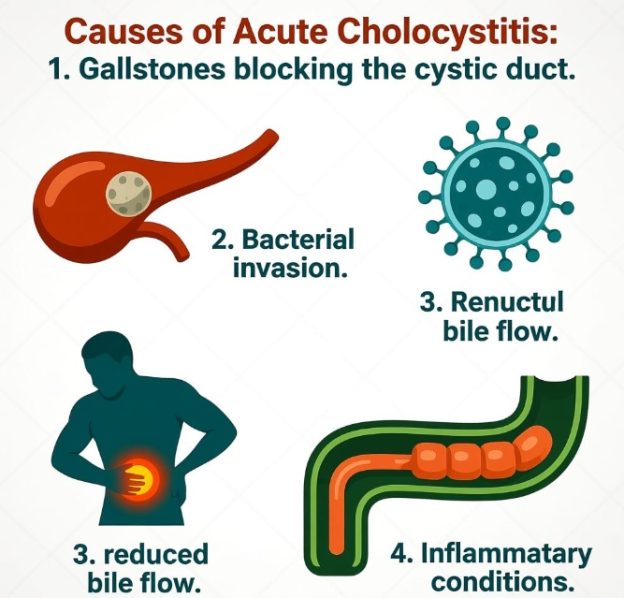Acute cholecystitis is acute inflammation of the gall-bladder wall, initiated most often by cystic-duct obstruction with secondary bacterial infection. The clinical picture evolves over hours, and recognition of its characteristic features guides early imaging, antibiotic therapy, and timely surgical intervention.
- Right-upper-quadrain pain
Persistent, often severe pain begins beneath the costal margin, may radiate to the right scapula or inter-scapular region, and is exacerbated by deep inspiration or movement. Pain typically lasts > 6 h and is unrelenting. - Murphy sign
Inspiratory arrest elicited by palpation of the right upper quadrant during deep inspiration is a reliable physical finding; a positive Murphy sign has high diagnostic accuracy. - Fever and systemic response
Low-grade pyrexia (37.5–38.5 °C) with chills is usual; higher temperatures or rigors suggest suppurative complications such as empyema or gangrene. - Nausea and vomiting
Gastric stasis and vagal reflexes produce repeated retching that may transiently lessen pain but contributes to dehydration and electrolyte imbalance. - Tender hepatomegaly and guarding
The gall-bladder fundus is palpable as a smooth, exquisitely tender mass; voluntary guarding progresses to board-like rigidity if peritonism develops. - Laboratory inflammation
Leukocytosis with neutrophil left shift, elevated C-reactive protein, and modest rise in serum alkaline phosphatase and transaminases are characteristic; total bilirubin may be mildly elevated unless common bile-duct stones coexist. - Local complications
Persistent high fever, unrelenting pain, or palpable emphysematous crepitus indicates gangrene, perforation, or emphysematous cholecystitis and mandates urgent intervention.
| Symptom / Sign | Typical Presentation |
|---|---|
| RUQ pain | Persistent > 6 h, radiates to scapula |
| Murphy sign | Inspiratory arrest on palpation |
| Fever | Low-grade, chills; high if suppurative |
| Nausea/vomiting | Repeated, may relieve pain transiently |
| Tender mass | Smooth, exquisitely tender gall-bladder |
| Laboratory | Leukocytosis, ↑ CRP, ↑ ALP/ALT |
| Alarm signs | High fever, crepitus, unrelenting pain |
